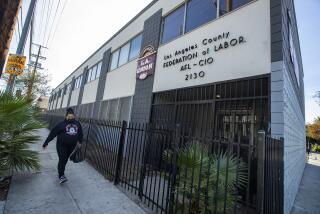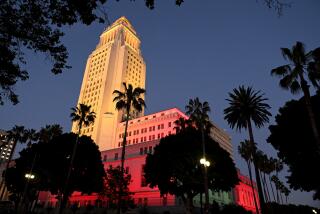Language Barrier : Jargon-Laden City Hall Parlance Could Drive Listeners BANANAs
- Share via
A debate over who should manage a quake-debris cleanup program was heating up in Los Angeles City Hall recently when Councilman Mike Hernandez stood and asked city staff about the participation of “WeeBees” and “MeeBees.”
To City Hall newcomers, it may have sounded as if Hernandez had cracked under pressure and begun to speak gibberish. But in fact he was simply using City Hall jargon to refer to the Women Business Enterprise and Minority Enterprise contractors, who would get work through the program.
The expressions are part of a growing lexicon of acronyms and imaginative terms that make up the parlance of City Hall, a language spoken fluently by political insiders that is Greek to just about everyone else.
In fact, everyday conversation in City Hall has become so full of bureaucratese that a council aide has drafted a 20-page dictionary of City Hall acronyms to help council newcomers become literate in the lingo.
Francine Oschin, an aide to San Fernando Valley Councilman Hal Bernson, said the idea for the dictionary was born three years ago after she attended a meeting of SCAG (the Southern California Assn. of Governments) to discuss ISTEA (the federal Intermodal Surface Transportation Efficiency Act).
“It was like listening to alphabet soup,” she said. “You spent so much time trying to figure out what was said in the past two sentences that you lost what was being said.”
And new acronyms are coined every day. For example, the engineers who were assigned to oversee the quake-debris cleanup program have dubbed themselves the Northridge Earthquake Recovery Department, or NERD.
Just as some languages have regional dialects, almost every city department has its own expressions and acronyms.
In the Bureau of Sanitation, trash collectors use the term junkin to refer to the act of removing and keeping items discarded with garbage, as in: “He found that chair while he was junkin.”
And most trash collectors cringe when they are called out to a DAC, a Dead Animal Collection.
In the Street Maintenance Department, a skin patch is a thin layer of asphalt used to repair a pothole and a dog wagon is a trailer used to carry tools.
*
Some zoning officials use the acronym BANANA (Build Absolutely Nothing Anywhere Near Anything) to poke fun at homeowners who oppose development. On the other hand, a project opposed by neighbors can be called a LULU (Locally Unwanted Land Use).
Planning officials often toss around terms such as NegDec to refer to a negative declaration--a decision that a development project will have no significant environmental impact.
And they say that before the city approves a controversial project, it must be considered by PLUM, the council’s committee on Planning and Land Use Management.
Many community activists see the increasing use of such government jargon as part of the reason the public is sometimes reluctant to participate in local politics.
“The jargon is intimidating,” said Richard Close, president of the Sherman Oaks Homeowners Assn. “The uninitiated (go) to a public hearing and they don’t know what is going on, but a lawmaker or a lobbyist knows what is going on.”
Nonetheless, Close, who has been active in civic affairs for nearly 20 years and has become well versed in the jargon, said the language can be learned relatively quickly.
Other homeowner representatives simply shrug at the use of bureaucratic jargon, accepting it as an inherent part of local government.
“If you are going to be active in civic affairs, you have to deal with it,” said Barbara Fine, vice president of the Federation of Hillside and Canyon Assns., which represents home and property owners on both sides of the Santa Monica Mountains.
One San Fernando Valley homeowner protested to a City Council planning committee in January about the use of confusing “legalese” in newspaper notifications issued by the city to tell residents of neighborhood land-use issues.
Some City Hall insiders say they are trying to cut down on jargon. “When you start sounding like a bureaucrat, you lose that connection” with the public, said Greg Nelson, an aide to Councilman Joel Wachs.
About five years ago, then-council member Gloria Molina became so upset over the use of bureaucratic gibberish that she suggested an ordinance to require the use of more simple language in official documents. She was told that such an ordinance already existed but was generally ignored because no one understood it.
*
Within the council chambers, the city’s lawmakers bat around many official-sounding terms and expressions that actually have simple, down-to-earth definitions. For example, to receive and file a report simply means to put it away. When a council member says, “I move the previous question,” it means, “Let’s stop talking and vote.”
After an ordinance is adopted, the council president sometimes says, “Forthwith on that,” which simply tells the city clerk to hurry the item to the mayor for final approval.
Some of the city’s lower-level managers use the term Emerald City to refer to the second and third floors of City Hall, where offices for the mayor and council members are located. And when they are called to testify before the council, they say they are being called to the horseshoe, because the council members’ desks are arranged in a horseshoe shape around the speaker.
Translating City Hall Here are some commonly used acronyms and expressions at Los Angeles City Hall.
* BANANA: Build Absolutely Nothing Anywhere Near Anything
How it’s used: In private by planning officials and council members when they run across residents who oppose even the most innocuous project. “How could they oppose that project? They must be BANANAs.”
* CUP: Conditional Use Permit, usually required of controversial projects.
How it’s used: Planning, zoning and council members use this acronym routinely at public hearings. “Without a CUP, that project is dead in the water.”
* Emerald City: Second and third floors of City Hall.
How it’s used: This is a pejorative term used among lower-level managers to poke fun at the council members and mayor who work on those two floors. “Get a load of him. He’s wearing his best suit for a meeting in Emerald City.”
* The horseshoe: The U-shaped configuration of desks where council members sit during meetings.
How it’s used: By regulars at council meetings. “Have you heard the latest rumors around the horseshoe?”
* LULU: Locally Unwanted Land Use.
How it’s used: By planning officials and others to describe a project opposed by nearby residents. “Is that project going to be approved or is it a LULU?”
* NIMBY: Not In My Back Yard
How it’s used: To describe people opposed to a project because it is nearby. “You can expect opposition from that group. They’re NIMBYs.”
* REAP: Rent Escrow Account Program. The city puts rents from dilapidated apartment buildings into an account until the owner makes repairs.
How it’s used: Often by zoning administrators. “Let’s put that building into REAP and hope the landlord shapes up.”
More to Read
Sign up for Essential California
The most important California stories and recommendations in your inbox every morning.
You may occasionally receive promotional content from the Los Angeles Times.














